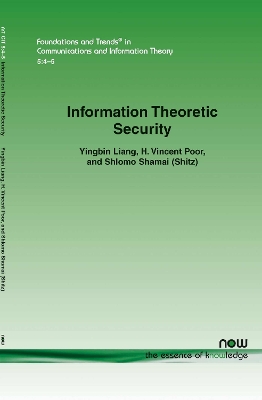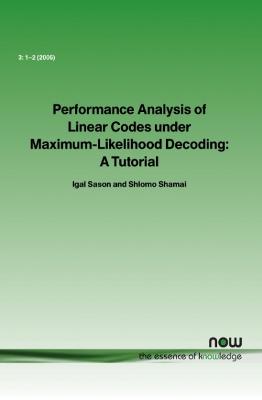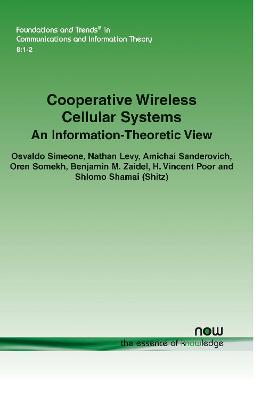Foundations and Trends (R) in Communications and Information Theory
3 total works
Information Theoretic Security
by Yingbin Liang, H. Vincent Poor, and Shlomo Shamai
Published 1 January 2009
Security is one of the most important issues in communications. Security issues arising in communication networks include confidentiality, integrity, authentication and non-repudiation. Attacks on the security of communication networks can be divided into two basic types: passive attacks and active attacks. An active attack corresponds to the situation in which a malicious actor intentionally disrupts the system. A passive attack corresponds to the situation in which a malicious actor attempts to interpret source information without injecting any information or trying to modify the information; i.e., passive attackers listen to the transmission without modifying it.
Information Theoretic Security focuses on confidentiality issues, in which passive attacks are of primary concern. The information theoretic approach to achieving secure communication opens a promising new direction toward solving wireless networking security problems. Compared to contemporary cryptosystems, information theoretic approaches offer advantages such as eliminating the key management issue; are less vulnerable to the man-in-the-middle and achieve provable security that is robust to powerful eavesdroppers possessing unlimited computational resources, knowledge of the communication strategy employed including coding and decoding algorithms, and access to communication systems either through perfect or noisy channels.
Information Theoretic Security surveys the research dating back to the 1970s which forms the basis of applying this technique in modern systems. It proceeds to provide an overview of how information theoretic approaches are developed to achieve secrecy for a basic wire-tap channel model as well as for its extensions to multiuser networks. It is an invaluable resource for students and researchers working in network security, information theory and communications.
Information Theoretic Security focuses on confidentiality issues, in which passive attacks are of primary concern. The information theoretic approach to achieving secure communication opens a promising new direction toward solving wireless networking security problems. Compared to contemporary cryptosystems, information theoretic approaches offer advantages such as eliminating the key management issue; are less vulnerable to the man-in-the-middle and achieve provable security that is robust to powerful eavesdroppers possessing unlimited computational resources, knowledge of the communication strategy employed including coding and decoding algorithms, and access to communication systems either through perfect or noisy channels.
Information Theoretic Security surveys the research dating back to the 1970s which forms the basis of applying this technique in modern systems. It proceeds to provide an overview of how information theoretic approaches are developed to achieve secrecy for a basic wire-tap channel model as well as for its extensions to multiuser networks. It is an invaluable resource for students and researchers working in network security, information theory and communications.
Performance Analysis of Linear Codes under Maximum-Likelihood Decoding
by Igal Sason and Shlomo Shamai
Published 7 July 2006
This book focuses on the performance evaluation of linear codes under optimal maximum-likelihood (ML) decoding. Though the ML decoding algorithm is prohibitively complex for most practical codes, their performance analysis under ML decoding allows to predict their performance without resorting to computer simulations. It also provides a benchmark for testing the sub-optimality of iterative (or other practical) decoding algorithms.
This analysis also establishes the goodness of linear codes (or ensembles), determined by the gap between their achievable rates under optimal ML decoding and information theoretical limits. In this book, upper and lower bounds on the error probability of linear codes under ML decoding are surveyed and applied to codes and ensembles of codes on graphs. For upper bounds, the authors discuss various bounds where focus is put on Gallager bounding techniques and their relation to a variety of other reported bounds. Within the class of lower bounds, they address de Caen's based bounds and their improvements, and also consider sphere-packing bounds with their recent improvements targeting codes of moderate block lengths.
Performance Analysis of Linear Codes under Maximum-Likelihood Decoding is a comprehensive introduction to this important topic for students, practitioners and researchers working in communications and information theory.
This analysis also establishes the goodness of linear codes (or ensembles), determined by the gap between their achievable rates under optimal ML decoding and information theoretical limits. In this book, upper and lower bounds on the error probability of linear codes under ML decoding are surveyed and applied to codes and ensembles of codes on graphs. For upper bounds, the authors discuss various bounds where focus is put on Gallager bounding techniques and their relation to a variety of other reported bounds. Within the class of lower bounds, they address de Caen's based bounds and their improvements, and also consider sphere-packing bounds with their recent improvements targeting codes of moderate block lengths.
Performance Analysis of Linear Codes under Maximum-Likelihood Decoding is a comprehensive introduction to this important topic for students, practitioners and researchers working in communications and information theory.
Cooperative Wireless Cellular Systems
by Osvaldo Simeone, Nathan Levy, Amichai Sanderovich, Oren Somekh, Benjamin M. Zaidel, H. Vincent Poor, and Shlomo Shamai
Published 17 August 2012
Cooperative Wireless Cellular Systems provides an information-theoretic view of the advantages of cooperation in wireless cellular systems.
The impact of cooperation on the performance of wireless cellular systems is studied from an information-theoretic standpoint, focusing on simple formulations typically referred to as Wynertype models. Following ongoing research and standardization efforts, the text covers two main classes of cooperation strategies.
The first class is cooperation at the base station (BS) level, which is also known as Multi-Cell Processing (MCP), network Multiple-Input Multiple-Output (MIMO), or Coordinated Multi-Point transmission/reception (CoMP). With MCP, cooperative decoding, for the uplink, or encoding, for the downlink, is enabled at the BSs. MCP is made possible by the presence of an architecture of, typically wired, backhaul links connecting individual BSs to a central processor (CP) or to one another.
The second class of cooperative strategies allows cooperation in the form of relaying for conveying data between Mobile Stations (MSs) and BSs in either the uplink or the downlink. Relaying can be enabled by two possible architectures. A first option is to deploy dedicated Relay Stations (RSs) that are tasked with forwarding uplink or downlink traffic. The second option is for the MSs to act as RSs for other MSs.
MCP is first studied under ideal conditions on the backhaul links, namely by assuming that all BSs are connected to a CP with unlimited-capacity links. Both Gaussian (nonfading) and flat-fading channels are analyzed, for the uplink and the downlink, and analytical insights are drawn into the performance advantages of MCP in different relevant operating regimes. Performance comparison is performed with standard Single-Cell Processing (SCP) techniques, whereby each BS decodes, in the uplink, or encodes, in the downlink, independently, as implemented with different spatial reuse factors. Then, practical constraints on the backhaul architecture enabling MCP are introduced. Specifically, three common settings are studied. In the first, all the BSs are connected to a CP via finite-capacity links. In the second, only BSs in adjacent cells are connected via (finite-capacity) backhaul links. In the third, only a subset of BSs is connected to a CP for joint encoding/decoding (clustered cooperation). Achievable rates for the three settings are studied and compared for both the uplink and the downlink.
The performance advantages of relaying are analyzed for cellular systems with dedicated RSs and with cooperative MSs. Different techniques are reviewed that require varying degrees of information about system parameters at the MSs, RSs, and BSs. Performance is investigated with both MCP and SCP, revealing a profound interplay between cooperation at the BS level and relaying. Finally, various open problems are pointed out.
The impact of cooperation on the performance of wireless cellular systems is studied from an information-theoretic standpoint, focusing on simple formulations typically referred to as Wynertype models. Following ongoing research and standardization efforts, the text covers two main classes of cooperation strategies.
The first class is cooperation at the base station (BS) level, which is also known as Multi-Cell Processing (MCP), network Multiple-Input Multiple-Output (MIMO), or Coordinated Multi-Point transmission/reception (CoMP). With MCP, cooperative decoding, for the uplink, or encoding, for the downlink, is enabled at the BSs. MCP is made possible by the presence of an architecture of, typically wired, backhaul links connecting individual BSs to a central processor (CP) or to one another.
The second class of cooperative strategies allows cooperation in the form of relaying for conveying data between Mobile Stations (MSs) and BSs in either the uplink or the downlink. Relaying can be enabled by two possible architectures. A first option is to deploy dedicated Relay Stations (RSs) that are tasked with forwarding uplink or downlink traffic. The second option is for the MSs to act as RSs for other MSs.
MCP is first studied under ideal conditions on the backhaul links, namely by assuming that all BSs are connected to a CP with unlimited-capacity links. Both Gaussian (nonfading) and flat-fading channels are analyzed, for the uplink and the downlink, and analytical insights are drawn into the performance advantages of MCP in different relevant operating regimes. Performance comparison is performed with standard Single-Cell Processing (SCP) techniques, whereby each BS decodes, in the uplink, or encodes, in the downlink, independently, as implemented with different spatial reuse factors. Then, practical constraints on the backhaul architecture enabling MCP are introduced. Specifically, three common settings are studied. In the first, all the BSs are connected to a CP via finite-capacity links. In the second, only BSs in adjacent cells are connected via (finite-capacity) backhaul links. In the third, only a subset of BSs is connected to a CP for joint encoding/decoding (clustered cooperation). Achievable rates for the three settings are studied and compared for both the uplink and the downlink.
The performance advantages of relaying are analyzed for cellular systems with dedicated RSs and with cooperative MSs. Different techniques are reviewed that require varying degrees of information about system parameters at the MSs, RSs, and BSs. Performance is investigated with both MCP and SCP, revealing a profound interplay between cooperation at the BS level and relaying. Finally, various open problems are pointed out.


